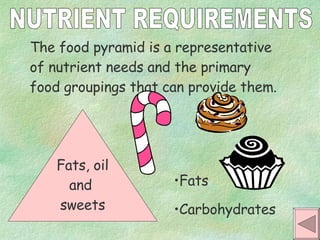Balanced Diet
- 1. Sue Harmon Teacher Page THE FOOD PYRAMID AND A BALANCED DIET
- 2. should be based on: energy needs food preferences nutrient requirements as represented on the food pyramid. SELECTING APPROPRIATE FOODS FOR A BALANCED DIET. . .
- 3. Nutrient needs change as you grow. THE FIVE FOOD GROUP PYRAMID Meat(poultry), fish Fruit Fats, oils and sweets Milk, cheese Vegetables Bread, cereal 6-11 servings 2-4 servings 3-5 servings 2-3 servings 2-4 servings use little
- 4. ENERGY NEEDS To be fit you should maintain a healthy weight. Extra activity requires extra calories. Children and teens need more calories than adults. Taller and bigger people need more calories than shorter and smaller people.
- 5. FOOD PREFERENCES Using foods that you enjoy and that are readily available to you, develop a one day menu that will meet the requirements on the food pyramid. Write your menu in your journal.
- 6. NUTRIENT REQUIREMENTS The food pyramid is a representative of nutrient needs and the primary food groupings that can provide them. Fats, oil and sweets Fats Carbohydrates
- 7. Milk, yogurt, cheese NUTRIENT REQUIREMENTS Fats Protein Vitamins, cheese and minerals
- 8. Meat, poultry, fish NUTRIENT REQUIREMENTS Protein Fats Vitamins Minerals
- 9. NUTRIENT REQUIREMENTS Vegetables Vitamins and minerals Protein Carbohydrates
- 10. NUTRIENT REQUIREMENTS Fruit Vitamins Minerals Carbohydrates
- 11. NUTRIENT REQUIREMENTS Bread, cereal, grains Carbohydrates Vitamins Minerals
- 12. NUTRIENTS are used by the body for energy, growth, repair and cellular needs. Nutrient Function FATS Provide the body with a stored form of energy, warmth and insulation for body organs.
- 13. CARBOHYDRATES Provide the body with an immediate source of energy. PROTEIN Helps the body grow, makes muscles strong and repairs body tissues.
- 14. VITAMINS AND MINERALS Help to release energy and help the body perform many functions including: fighting infections and making strong bones and teeth.
- 15. Using the information from the food pyramids and the following nutrient abbreviations, complete the following chart. F=fat C=carbohydrates P=protein VM=vitamins and minerals
- 16. Pyramid Group Write the chart in your journal C, VM Fruit VM Vegetable C, VM Bread, cereal F, P, VM Meat, poultry F, P Milk P, F, VM Meat Food Nutrient Pork chop Orange Carrot Wheat Bread Chicken Cheese Peanut Butter P, F, VM Meat
- 17. Summary The following guidelines may be used toward better nutrition. No guidelines can guarantee health or well-being, but they may give you the start you need. Eat a variety of foods. Maintain healthy weight. Avoid too much saturated fat and cholesterol. Eat foods with adequate starch and fiber.
- 18. TEACHER PAGE Objective- The students will see the food pyramid and the foods and nutrients involved with it. Activity- The students will be given choices and selections to make and should write them and the questions in their journal. Process- Follow the slides. Some answers will appear slowly and do not require a mouse click.

















